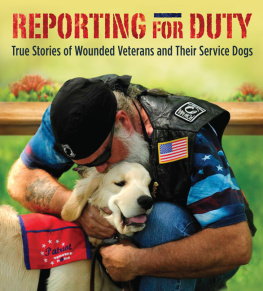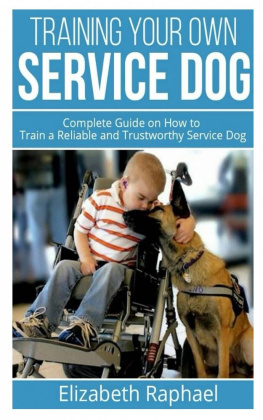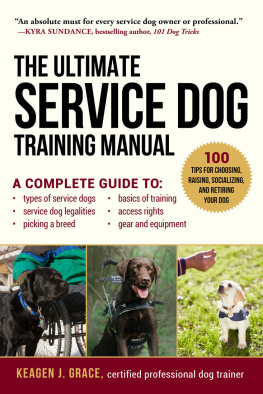TABLE OF CONTENTS
INTRODUCTION
If you've ever met a service dog, you understand how unique these companions are. They guide and protect, as well as lead and follow. A service dog frequently becomes a best friend in a mutually beneficial relationship. Maybe you've always been curious about how service dogs are trained for their specialized tasks, or maybe you're in a situation where you or someone you care about could benefit from service dog interaction. You could have arrived here in a variety of ways, but something within you has sparked a desire to work more closely with animals and foster closer relationships between animals and humans.
These amazing and loving animals will enrich your life in unimaginable ways. Whether you are disabled, a potential trainer, or simply a dog lover, this book will teach you everything you need to know about service dogs. Much of the information also applies to other service animals. In many cases, the information is applicable to all pet dogs.
This book will provide you with a better understanding of service dog etiquette and laws, professional training terminology, and the mental and physical tools you'll need to succeed in this endeavor. I've organized the book in stages of progression. It is critical not to skip any steps in the process and to lay a solid foundation for your personalized service dog.
Enjoy!
CHAPTER 1
Introduction to Dog Training and Service Dog Training

A service dog is a canine that has been specifically trained to perform physical tasks or work for a disabled person. This training covers a wide range of disabilities, including vision, hearing, and mobility issues. It can also address seizure alerts, adhere to the person's protection during the episode, and participate in the revival techniques. These dogs require individualized training, which means they are trained to meet the needs of a single person. Training can be provided by the disabled person or by a professional organization and trainer. At this time, no special licensing or certification is required. They are not required to wear outerwear or carry any special signage. They aren't even considered house pets.
Assistance Dog - This is a broader term that includes the majority of the other working dog categories. Essentially, this type of dog assists with various life functions. They are trained to direct, signal, and/or perform physical tasks for their owner. These tasks frequently include retrieving household items, such as cell phones, dropped items, or misplaced items. This term also refers to seizure-alert dogs as well as dogs used in the treatment of psychiatric or psychological disorders.
Guide Dog - This is the most literal term and refers to visually impaired people who require assistance in navigating their surroundings. Normally, these animals are formally trained for guide (Seeing Eye) dogs by an accredited institution.
Therapy dogs, unlike the other three types of dogs mentioned, are not protected under federal law (ADA). You ought to,
Check the state laws in which you live, however, as some states have granted dogs additional rights within their borders. These dogs are considered pets who provide emotional support and well-being to others but are not associated with any specific physical or life support functions. These sweet animals are frequently taken to hospitals or nursing homes. They can bring comfort to the sick and companionship to senior citizens who are confined to their homes.
There is one more distinction, which is usually the source of the most confusion. Emotional assistance dogs are not technically therapy dogs. Therapy dogs provide emotional support in the short term. An emotional assistance dog is considered necessary for an emotionally impaired person to function on a daily basis. As a result, an emotional assistance dog is protected by the Fair Housing Act, allowing a person to own one even where "no dog" policies apply.
Who Is Eligible for a Service Dog?
A service dog is available to anyone with a disability. As a result, the question is, "Is this condition a disability?" This may sound amusing in a broad sense to those suffering from a disability, but it is important to remember that disabilities are legal issues, not medical ones. A report detailing a diagnosis from a physician, psychologist, or psychiatrist is very good evidence, but it is not the final determination. Federal and state regulations will ultimately determine who is eligible to receive a service dog legally.
The process governed by the Social Security Administration in the United States is an excellent example. Most of us have seen one of numerous commercials and advertisements featuring an attorney who will represent a person seeking social security disability benefits.
To elaborate on that point, many people receiving social security insurance (SSI) would be unable to legally qualify for service animal assistance.
The key term in the preceding definition is "substantially limits." If what is commonly considered a disability can be corrected or avoided by taking medication or other forms of assistance, it is not a disability under the law. Assume you have poor vision and would like a guide dog to assist you in moving from place to place. If a pair of glasses or contact lenses correct your vision to an acceptable level, you are not considered disabled and thus do not qualify for a service dog.
Another qualifying factor is what the ADA calls a "major life activity." "Major life activities" are typically those that have an impact on one's breathing, walking, thinking, seeing, or hearing. The best explanation for this could be that an individual would be unable to get through the day without the assistance of a service dog. Opening doors, walking, and sending alert signals are just a few examples. Making life easier or more comfortable is not included. The law may appear harsh, but strict guidelines must be established to prevent abuse and slanted interpretations.
The ADA was revised in 2010 to clarify what constitutes a disability. It goes on to list several physical and mental brain and body conditions that may entitle one to use a service dog. These disorders include, but are not limited to, any ailments or illnesses affecting the cardiovascular system, neurological system, respiratory system, muscle and skeletal system, and other special sense organs.
Under the right circumstances, the mentally challenged, as well as all forms of mental illness and emotional issues, can all be considered disabilities.
There are numerous other diseases that may require the assistance of a service dog. Cancer, cerebral palsy, epilepsy, multiple sclerosis, and muscular dystrophy are among them. Diabetes, alcoholism, and drug addictions can all fall into this category and, in some cases, qualify for service animal assistance.
Age, race, and sexual orientation have no bearing on one's disability status, nor do they qualify for the use of a service dog.
To summarize, the standards for who qualifies for a service dog are largely open to interpretation and are a legal issue that must meet the specified criteria as set forth by federal and state laws. As previously stated, disabilities are legal issues rather than medical ones. Federal and state regulations will ultimately determine who is eligible to receive a service dog legally.
How to Get a Service Dog That Has Already Been Trained
So you've decided to go ahead with the purchase of a professionally trained service dog. The next question is, where can I get one? What are the available options?








